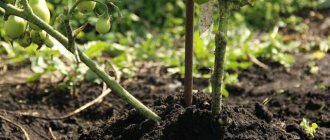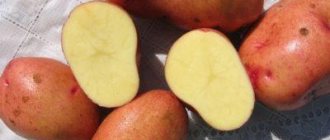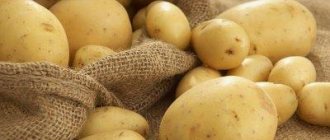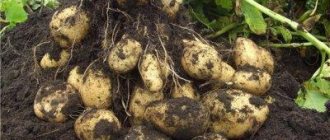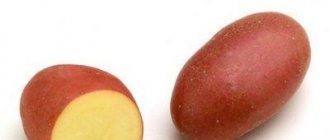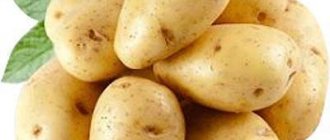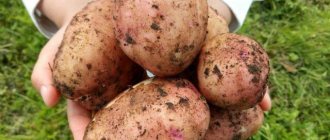Description of the variety Laura
| Variety name | Laura |
| general characteristics | mid-early table variety with beautiful pink tubers |
| Maturation period | 70-80 days |
| Starch content | 15-17% |
| Weight of marketable tubers | 90-150 gr |
| Number of tubers in a bush | up to 20 |
| Productivity | 332-520 c/ha |
| Consumer qualities | good taste, suitable for any dish |
| Keeping quality | 90% |
| Peel color | pink |
| Flesh color | yellow |
| Preferred Growing Regions | any black earth regions |
| Disease resistance | moderately resistant to all diseases and viruses |
| Features of cultivation | Additional watering is required |
| Originator | Europlant Pflanzenzucht GmbH (Germany) |
The Laura potato variety is a mid-early variety; the period from main shoots to technical maturity (potatoes have a dense skin and the required size) averages 80 days.
Potatoes can be consumed a little earlier than their technical maturity, when the tubers reach acceptable sizes and the thin skin is well preserved.
Early and mid-early varieties are planted mainly for the consumption of young potatoes.
Root vegetables with greenish spots (appear if the potatoes have been in the sun for some time) are not suitable for consumption, as they contain solanine, a toxic substance.
The root crop is:
- The peel is dense, smooth, dark pink.
- The eyes are medium in size, located without indentations.
- The shape is oblong, almost regular oval.
- Weight - from 90 g to 150 g, dimensions - from 7 cm in length.
- The color and structure of the pulp is rich yellow and dense.
- Starch content - 15-17%.
Reference. Potatoes with a starch content of 14% to 25% are considered “high-starchy”, which means they are tasty. Potatoes are valued for their starch content.
The bush is spreading, tall, large, erect. The leaves are intermediate in shape, typical in shape for potatoes, the structure is wrinkled, without pubescence, medium in size, dark green in color. There are many inflorescences. The corolla of flowers is mostly white, but light purple flowers are also often found.
Climatic growing zones
The most successful regions for cultivation in the Russian Federation are Central and Northwestern, and successful cultivation in European countries.
"Laura", like some other potato varieties, due to its early ripening, ripens in any climatic conditions . However, it is not recommended to grow “Laura” in very dry regions or keep it in dry soil.
How to grow
Laura potatoes successfully tolerate almost any climatic conditions. It grows well in any soil, loam and sandy loam. The highest productivity is shown in black soil regions, but in arid regions the productivity of the variety is low.
Planting dates and scheme
The timing of planting varieties depends on the region. In cold soil, potatoes will rot and will not sprout, and late April frosts will completely destroy the plantings. Therefore, in the southern regions Laura is planted at the end of April, in the northern regions - in mid-May. The soil should be warmed up to +7...+8°C at a depth of 9-10 cm.
Before planting, seed potatoes are prepared. To do this, it is first sorted out, leaving only medium-sized, intact and disease-free tubers.
The next stage is germination for 12–14 days in the sun or light. Then the tubers are treated with products based on zinc, boron or manganese, and sprayed with a solution of gibberellin or sodium humate.
Mineral and bacterial additives are added to the soil:
- superphosphate in granules;
- urea;
- nitrogen-bacterial fertilizing "Ecofit";
- nitrophoska;
- phosphorus-bacterial “Bactophosphine”;
Planting is carried out according to the standard scheme:
- Dig holes no more than 10 cm deep. If the soil is not fertile enough, then add humus or a handful of ash to the depressions.
- The distances between the holes are 30–40 cm.
- 60–70 cm are left between the rows to provide the bushes with aeration and simplify hilling.
Important! Potatoes are not planted next to tomatoes: they have the same diseases and pests.
After planting, the ground is leveled with a rake. During the flowering period, the flowers are picked off so that the tubers receive more nutrients.
Care
To obtain a large harvest, potatoes are provided with proper care. The Laura variety loves watering: it is irrigated at least 3 times per season:
- For the first time - 3 weeks after germination.
- Then before the flowers appear on the tops. During this period, the crop needs water most.
- Water the last time before the end of flowering. After waterlogging of the soil leads to the development of fungal diseases.
Proper soil treatment plays an important role in maintenance. The formation of large tubers depends on this. The main nuances of soil cultivation around potatoes:
- Weeds are removed throughout the growing process: they take nutrients from the ground, attract pests and shade young potato sprouts.
- The soil around the bushes is regularly loosened: this ensures access of water and air to the roots.
- Potato beds are mulched with dry straw to reduce the frequency of watering and weed growth.
- After the tops grow to a length of about 20 cm, the bushes are hilled to saturate the roots with oxygen, increase the number of new stolons, and increase productivity.
- After the first hilling, the procedure is repeated every 3 weeks.
The crop reacts negatively to a lack of potassium in the soil, so it is fed with potassium magnesium throughout the growing season. The product improves the quality of tubers by increasing the amount of starch in them.
Nuances of cultivation and possible difficulties
Although Laura potatoes are easy to care for, there are some difficulties in cultivating them:
- need for frequent watering;
- proper care of the soil in the beds;
- preparing soil and potato seeds before planting;
- compliance with the bush placement scheme;
- compliance with crop rotation rules;
Diseases and pests dangerous to the variety:
- Black leg . A characteristic sign is a black coating on the lower part of the stem. The tops turn yellow and rot, and are easy to pull out of the ground. The tubers are covered with wet mucus. The disease has no cure. Affected bushes are removed, the soil is disinfected with a solution of 1 tbsp. l. copper sulfate with 1 tbsp. ash.
- Colorado beetle. Insects lay eggs on the leaves, and beetle caterpillars (larvae) eat the tops. This significantly worsens the harvest. If the number of adults and larvae is small, they are collected by hand. In case of severe damage, use the Kinmiks insecticide according to the instructions.
- Wireworm. The pest makes tunnels in the tubers, as a result the potatoes are not stored for long. To combat wireworms, fresh potatoes and carrots are placed on wooden sticks and buried to a depth of about 10 cm. After some time, they are removed from the soil along with the insects.
- Medvedka. The insect lives underground, eats roots and tubers. They get rid of it with an infusion of hot pepper and water or with the help of chemicals.
The variety is resistant to nematodes, leaf curl, Y-virus and scab, and has relative immunity to late blight.
Important! The last chemical treatment against pests is carried out no less than 30 days before harvest.
Characteristics
Productivity
The variety's yield is high - from 330 centners per hectare; more than 20 large potatoes can be obtained from one plant under favorable weather conditions and proper agricultural technology.
Reference. Potatoes should be planted at average temperatures, preferably in mid-to-late May, when soil temperatures are quite high.
You can compare the yield indicators of Laura potatoes with other varieties in the table below:
| Variety name | Productivity |
| Laura | 330-520 c/ha |
| Beauty | 400-450 c/ha |
| Vector | 670 c/ha |
| Artemis | 220-350 c/ha |
| Yanka | up to 630 c/ha |
| Svitanok Kyiv | up to 460 c/ha |
| Santana | 160-380 c/ha |
| Nevsky | 300-500 c/ha |
| Taisiya | up to 460 c/ha |
| Colomba | 220-420 c/ha |
| Lapot | 400-500 c/ha |
Methods of use and taste
"Laura" is a table variety (culinary type "B"), suitable for human consumption. Thanks to the large amount of starch, it is excellent for making mashed potatoes and French fries. The quality of the potato and its correct shape predispose it to be grown for sale.
"Laura" has an excellent taste and rich aroma. Does not change color during heat treatment. Potatoes with a high starch content, combined with good taste, have an anti-ulcer effect.
Juice from yellow, red-skinned potatoes is better for lowering blood pressure and blood sugar levels. Laura contains a lot of nutrients and vitamins (potassium, calcium, phosphorus, vitamin C, etc.).
Sprouted root vegetables are not recommended for consumption, although the peel with sprouts is useful for various cosmetic masks.
Potatoes store well. You can read more about shelf life, temperature and possible problems on our website. And also about how to store root vegetables in winter, on the balcony, in the refrigerator, in boxes and peeled.
Growing
Inventory
To plant potatoes in small garden plots, it is better to use manual labor, which means you will need time-tested garden tools:
- bayonet shovel;
- a special shovel for harvesting potatoes or a pitchfork;
- hoe;
- hand hoe;
- rake.
Soil preparation
To obtain a good harvest, Laura variety potatoes require fertile soil. Therefore, it is necessary to prepare the soil in the fall by scattering manure or other organic fertilizers over the area, and then carefully digging everything up. In spring, the soil is cultivated again and a small amount of nitrogen-containing fertilizer is added.
Preparation of planting material
- Medium-sized tubers (the size of a chicken egg) are selected for planting. Root crops must have the correct shape without mechanical damage or signs of disease.
- The tubers must be germinated 10-12 days before planting - this will ensure uniform germination.
- After germination, the tubers must be treated with preparations containing copper, zinc or manganese. Gibberellin solution is very suitable for seed treatment.
Boarding time
The best time for planting this variety in central Russia is mid-May; by this time the soil has warmed up to a temperature of 10-12°C, which will ensure favorable germination.
Scheme
Our gardeners use two methods of planting potatoes - ridge and smooth. With any of these planting methods, it is important to adhere to the following rules:
- no more than 5 root crops are planted per linear meter;
- hole depth - about 20 cm;
- Row spacing is at least 60 cm.
It is advisable to add humus mixed with wood ash to the hole.
Care
Potatoes of the Laura variety require careful care from the gardener, and it will be difficult for a beginner to grow a good harvest, but everyone will be able to satisfy their personal needs.
- Hilling. As soon as the first shoots appear, it is necessary to carry out continuous harrowing, and throughout the entire vegetative cycle, the tops should be hilled up and the soil loosened.
- Watering. The Laura variety does not tolerate drought well. For normal tuber formation, the soil must be moist. This can provide automatic watering.
- Loosening and weeding. It is advisable to carry out these two activities simultaneously once a week before watering.
- Feeding. During intensive growth of tops, potatoes must be fed with nitrogen-containing fertilizers, but for the growth of tubers, a high potassium content in the soil is necessary. For this purpose, it is advisable to fertilize plants with potassium magnesium.
- Other care measures. The gardener must observe correct crop rotation, so the best predecessors for potatoes should be legumes, cabbage, cucumber, zucchini or beets.
Photo
In the photo you can see the Laura potato variety:
Care
Potatoes Spring
Proper care is very important for Laura potatoes:
- After the emergence of seedlings up to 8-10 cm in size, the planting area is treated by continuous harrowing. Throughout the growing season, it is necessary to loosen the plantings and clear them of weeds;
- Increasing the growth of tops immediately before the flowering stage requires large amounts of nitrogen. After flowering begins, the need for nitrogen gradually decreases;
- Potatoes are not too demanding on the quality of the soil and the presence of moisture, but require abundant watering during dry periods;
- The main feature of the Laura potato variety is the need for a sufficient amount of potassium in the soil. A deficiency of this substance leads to a slowdown in plant development. To increase productivity, improve the quality of tubers, and increase the amount of starch, it is recommended to use potassium magnesium;
- To cope with late blight, you need to treat the plantings with the following preparations: Ditan M-45, Kuproksat, Pilon. Kinmiks or wood ash powder helps to defeat the Colorado potato beetle.
Important! To get a high yield, you need to pay attention to weeding, loosening, hilling and fertilizing with mineral fertilizers.
You can reduce the burden of planting care if you grow potatoes under straw mats. This allows you to do without the procedure of loosening and hilling.
Potatoes under a straw mat
Advantages and disadvantages
"Laura" has the following positive qualities :
- large tuber sizes;
- high yield of neat tubers;
- average early maturity;
- resistance to certain diseases;
- high taste qualities;
- long storage.
There are also some disadvantages :
- low resistance to mechanical damage;
- there are some demands on the type of soil - you need a sufficient amount of potassium;
- reacts negatively to the herbicide Metribuzin.
The herbicide Metribuzin is used on large areas against weeds. If it is necessary to remove grass, it is recommended to apply this substance in the early stages of potato development, when the sprouts can be hidden underground.
“Laura” was developed by German scientists and breeders to replace the popular “Scarlett” variety. At the moment it is considered the most productive variety of red-skinned potatoes. The originator is German. It is not yet included in the State Register of the Russian Federation.
Planting potatoes
There are several ways to plant potatoes, but as a rule, two main ones are used - the ridge or smooth method. With the ridge method, you first need to prepare the soil - carefully dig up the selected area, then clear the soil of weeds and level it with a rake (crushing large pieces of earth). If the soil is not very fertile, and also to increase the yield, it is advisable to fertilize the soil with humus or manure.
Then you should level the soil with a rake. Then you need to use a shovel or cultivator to make holes for planting tubers. According to technology, it is best to plant from 5 to 7 tubers per linear meter. With this planting, you can get the maximum yield from the Laura variety. After the tubers are placed in the ground, you can add a little water (only if the soil is dry). After watering, you should also level the soil.
Agricultural technology
Laura seed potatoes should be prepared before planting - sorted from low-quality tubers (damaged by rodents or mechanically, small ones), exposed to light for about 10 days.
After good sprouts are formed, it is necessary to disinfect “Laura” for prevention ; treatment with fungicides is possible. "Laura" is planted in the middle - end of May.
IMPORTANT! Potatoes are not recommended to be planted next to tomatoes; they have the same diseases and pests.
The soil temperature at the planting depth (8 - 10 cm) should be at least 10 degrees. Very early or very late planting can adversely affect the harvest.
There should be at least 20 cm between plants, on average - 5 pieces per 100 cm (42,000 potatoes per 1 ha).
IMPORTANT! "Laura" develops many tubers; it is better to increase the distance between plants.
This variety responds well to quality care - loosening after rains, hilling, weeding, mulching, fertilizing with mineral fertilizers. Read more about how to feed potatoes, when and how to apply fertilizers, and how to do it correctly when planting.
In too dry summers, potatoes need good watering. During the flowering period of potatoes, it is better to remove the flowers, so all the development will go into the tubers. Potatoes quickly sprout and intensively develop tubers, then remain in a calm state.
Methods for growing potatoes may vary. We bring to your attention interesting materials about Dutch technologies, as well as about growing in barrels and bags, under straw and in boxes.
Preparing tubers for planting
As a rule, planting of this variety begins in April, when the soil has warmed up sufficiently. In order to plant tubers, it is necessary to carefully prepare the seed material. To do this, you need to sort through the existing seeds, removing tubers that are unsuitable for planting. Both deformed and small specimens that are rotten or diseased may be unsuitable.
The next stage is the vernalization of tubers, which means the germination of sprouts for 10-12 days in the sun or light. Then it is necessary to treat the planting material with special products based on copper, zinc, boron or manganese, and also treat with special fungicidal preparations. It would be a good idea to treat the seeds with a gibberellin solution.
Storage Features
Unlike most early varieties of potatoes, which are not stored for a long time, “Laura” keeps well for a long period (more than 90% of the tubers are preserved) if the temperature conditions are observed - these potatoes are best stored at constant temperatures of 1 - 3 degrees in a dark, ventilated place.
The ability to store well is an important quality for potatoes. In the table below you will find this characteristic for different varieties:
| Variety name | Keeping quality |
| Laura | 90% |
| Timo | 96% |
| Arosa | 95% |
| Spring | 93% |
| Vineta | 87% |
| Impala | 95% |
| Zorachka | 96% |
| Kamensky | 97% |
| Latona | 90% |
| Lyubava | 98% |
| Luck | 88-97% |
Reviews from vegetable growers
Potatoes "Laura" are generally highly rated and have positive reviews. Vegetable growers are attracted by the very beautiful elongated oval shape of the tubers with the rich yellow color of the tasty and aromatic pulp, which does not change during heat treatment. The variety is simply ideal for making high-quality French fries. The consumer properties are very high, and potato growers quite often grow this high-quality commercial variety of vegetable crop for the purpose of sale.
Potatoes: harvesting (video)
The variety is a mid-early variety and ripens well in almost any weather and climatic conditions. According to vegetable growers, the early emergence of seedlings is perfectly complemented by a high dormant period. Very good and long-term storage of the resulting crop was also noted.
DachaDecor.ru
Useful video
Watch the video: how to grow potatoes under hay or straw
Below in the table you will find links to articles devoted to potato varieties that ripen at different times:
| Mid-late | Mid-early | Late ripening |
| Aurora | Black Prince | Nikulinsky |
| belongings | Nevsky | Asterix |
| Courage | Dark-skinned girl | Cardinal |
| Rowanushka | Lord of the Expanses | Kiwi |
| Blue | Ramos | Slav |
| Zhuravinka | Taisiya | Rocco |
| Lasunok | Lapot | Ivan da Marya |
| Sorcerer | Caprice | Picasso |

